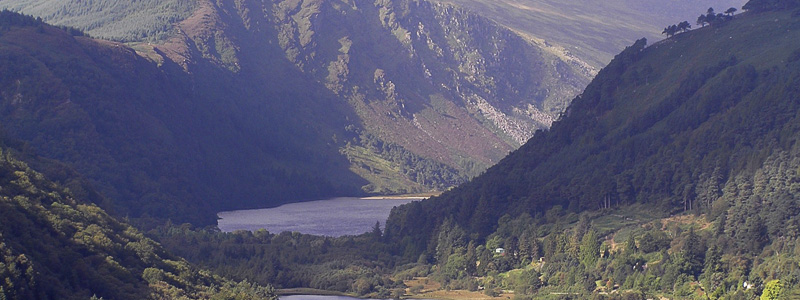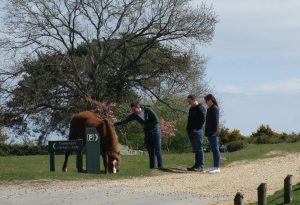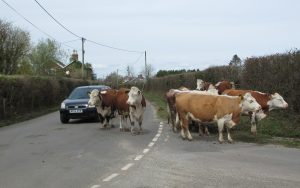By Dr Jo Ivey Co-ordinator: Shared Forest project, New Forest Commoners Defence Association
(in Volume 29)
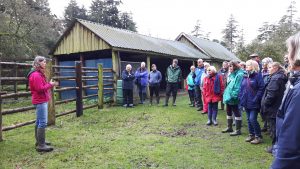
Lyndsey Stride talking to members of the New Forest Tourism Association about commoning (photo: Jim Mitchell)
Sixteen million people live within a 90-minute drive of the New Forest and the area receives some 13.5 million recreational visits each year[1], putting huge pressure on its infrastructure, natural environment and commoning management. It is England’s smallest and most intensely visited National Park. Yet it also has the highest concentration of designated wildlife sites of any of the English national parks, with 57% covered by statutory designations[2], with considerable overlap, and a further 5% as Sites of Importance for Nature Conservation.
The area’s unique character and landscape is sustained by its commoning heritage [3] which dates back to pre Norman times and the animals that are grazed by 700 commoners. Although the grazing animals and landscape are the visible New Forest that so many people love, the commoning community is seldom visible – and even less frequently understood – by the public.
While many English national parks are seeking ways to increase the volume of recreational activity, in the New Forest recreation has presented a serious problem for the management of the landscape and the commoned animals for many years. Commoning’s low profile has meant that the link between the management of the grazing animals and the landscape of the Forest has not been included in the dialogue with visitors and recreational users. As a result, many people do not identify the animals which they love to see, or the close-cropped ground on which they walk with the management work of the commoners, their ownership of the animals or the cultural heritage of the community.
The Sha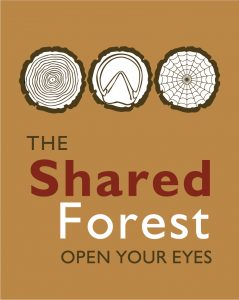 red Forest and Commoning Voices projects[4] have been working in different ways to achieve the same aim: to improve the flow of accurate and engaging information to the public and thus increase awareness of commoners as a distinct community with a long history and vibrant present whose animals and management work sustain the beauty and ecological diversity of the New Forest.
red Forest and Commoning Voices projects[4] have been working in different ways to achieve the same aim: to improve the flow of accurate and engaging information to the public and thus increase awareness of commoners as a distinct community with a long history and vibrant present whose animals and management work sustain the beauty and ecological diversity of the New Forest.
Shared Forest project
Although recreational users are one of its main audiences, the Shared Forest project is aimed at increasing awareness amongst everyone who lives in or visits the New Forest. The project started with research to investigate people’s understanding of commoning and the grazing animals, as well as the reasoning behind certain behaviours (such as feeding/petting ponies). This made clear that many assumptions about people’s attitudes and understanding need to be discarded:
- Hardly anyone knew anything about the commoning community;
- Very few local residents knew, or had even thought about, the fact that the animals are all owned by commoners;
- People who feed and pet ponies see no harm in what they are doing, and many think they are being caring.
Based on this information and using behaviour change techniques to design and implement our campaigns, we have worked to convey carefully considered messages about our community and animals to different sectors of the public. In many cases this has been sharing information about commoning and the grazing animals that people see on the Forest in attractive and accessible ways and combining some of the harder messages with interesting and positive facts and stories. In others it has been about seeing a situation from a different point of view.
Messages have been kept as simple as possible, avoided negative statements and approached the issues in ways which are most likely to affect people’s behaviour in positive ways. For instance, positive personalised messages are often more effective than negative effects on others: e.g. If you drive more slowly on the New Forest, you will be able to enjoy the scenery more.
We have used a number of different delivery methods: posters, leaflets, social media, local press and face-to-face interactions. We have also aimed to deliver the messages at the right time, so that their impact is likely to be greater. And we are aware that this is not a one-off operation, but something that needs to be repeated and built on over several years.
In the longer term we are hopeful that the positive information on which campaigns are based will become embedded in the local community, reinforcing positive behavioural norms that will not only help protect our animals and our commoning way of live, but also improve people’s experience of the New Forest as a unique and very special place.
To find out more about our methods and campaigns, go to www.newforestcommoners.com
This project is closely linked to the Commoning Voices project which is seeking to inform the public about the commoning community and the deep relationship that commoners have with the New Forest, their animals and each other.
Commoning Voices project
Social media is for many people the starting point for their visit to the countryside, yet when it comes to the New Forest there are presently no personal, trusted and reliable sources of information which show the commoning way of life or explain the link between the grazing of commoners’ animals and the fantastic flora and fauna of the New Forest. ‘Commoning Voices’ is an interpretation project which is empowering commoners to tell the story of the Real New Forest in their own authentic voices. People like to relate their own lives to the lives of others; by opening up and telling the personal stories of the commoning community it is hoped that visitors will empathise with the passion, pride and commitment of New Forest commoners.
The project began with workshops where commoners were encouraged to talk about their commoning lives, their relationships with the Forest, its wildlife and their animals. The workshops were extraordinary: once started it was almost impossible to stop people talking. Stories of special ponies, magical encounters and old Forest characters abounded but above all this the sense of enjoyment and passion that commoners have for their way of life, their community and that they simply loved talking about it!
Commoning is one big family: falling out, making up and working together.
From the initial workshops the project was shaped to include social media training for commoners, an audio project inspired by the Radio 4 Listening Project, ‘Meet the Commoners’ events 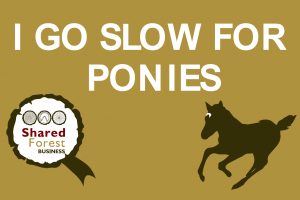 for various organisations including the National Park Authority, New Forest Tourism Association and local tour guides. These have been extremely successful in giving those who talk about the Forest some special nuggets of information about commoning to pass on to others. An interactive touring exhibition and Open Farm Sunday event are also planned for 2018.
for various organisations including the National Park Authority, New Forest Tourism Association and local tour guides. These have been extremely successful in giving those who talk about the Forest some special nuggets of information about commoning to pass on to others. An interactive touring exhibition and Open Farm Sunday event are also planned for 2018.
Since our training we now have several commoners regularly using Twitter, Instagram and Facebook to reveal the everyday story of commoning, sharing the pride and passion commoners have for their animals and the Forest. This, alongside the many events delivered by the project, will we hope bring about a subtle positive change in tone in the general conversation about commoning in the New Forest: a conversation which commoners and recreational visitors will want to engage with.
At the end of the day there are more ups than downs – but it’s just our way of life.
[1] Visitor Survey of the New Forest National Park 2004-2005 (Tourism South East)
[2] These include SSSI, SAC, SPA, Ramsar, LNR, NNR. Source: Nature in the New Forest: action for biodiversity, New Forest National Park Authority 2012
[3] Information about the area’s commoning heritage can be found at www.realnewforest.org
[4] These projects are part of the Our Past, Our Future Landscape Partnership in the New Forest, funded by the Heritage Lottery Fund.
